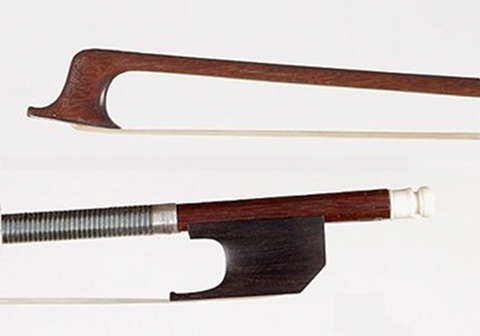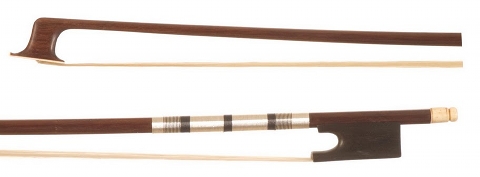CRAMER VERSUS CRAMER;OR RIGHTLY, THE EVOLUTIONARY PROCESS part IITo approach this period of bow making, is like submerging oneself in a very dense fog. Reliable information is very scarce, and what you find, often seems written in favour of the cause.
Violin Bow, Cramer Model 1770 cc. I apologize for being cryptic, but a delicate argument like this needs to be dealt with in a calm way. It is necessary to decide, which one was the final turning point in developing the modern bow, to stabilize who, or at least where modern architecture of bow making was located. The innovations introduced by Francois Xavier Tourte, with the help of Viotti, like the slide made in mother of pearl and the ring, are fundamental finishes, but remain so even if important. The true turning point occurs when the head was raised almost up to the same height as the frog. At that point, the bow had about the same measurements as the modern bow; same length; same curve, and most important is was made of: Pernambuco or Iron wood - the Cramer model. We don't know if the famous bow that arrived in Paris, in 1769, was made of iron wood or pernambuco, what we can note is that this structure was suitable to both types of wood, though with preference to the pernambuco; less dense and more elastic. One would think that the model was developed at the same time as the iron wood came to Europe from Asia, even though the pernambuco had been known in Europe, since the beginning of the 15th century, and could have been known in Germany, or to be precise in the Austrian province of the Holy Roman German Empire. It is difficult to state, if the pernambuco was used in France as a start. The first activity the conquistadores were keen to do was cut and import the wood to extract the resin and for building. In Portugal you will find houses, doors, tables and benches made of this wood from the 15th and the 16th century. It even seems that the name Brasile originates from Pao Brazil; common from Caesalpinia Echinata. What can be determined without doubt, is that the Cramer model arrived in Paris with a curve similar to the first modern bows; until Voirin to be precise. In this case I speak about the mechanic aspect, and not the history. If a bow with such a high head and frog did not have a curve it simply wouldn't function; maybe you remember the post I wrote years ago on acrobats on the wire? Have a look here at what happens when the tension is exaggerated. Our illustrious French colleagues, sustain in their book, without proof in favour - on the contrary that the pernambuco was used in France to begin with, and that the curve was introduced by the Tourte family. It is false, and they are aware of it, because they have made such a lot of bows and many very beautiful. They know well, how a bow with such a high head and without curve would function. So much that you only find one bow photographed in their book, with the bowhair tended to exhaustion to make it seem straight, a Cramer model by Nicolas Duchaine, previous to Nicolas Leonard Tourte (n.d.r.: L'Archet – Millant, Raffin, Gaudfroy, volume I, first part, p. 201). This may trick the reader, but anyone who understands the mechanics knows that the Cramer model had a concave curve, and was probably made in Pernambuco.
Violin Bow Tourte/Cramer 1780 The Tourte brothers have both been fundamental in the way they made bows; Francois Xavier had an extraordinary manual talent, and added innovations that have stabilized the final structure of the bow. You can see the first one in the photo above. Even though the German Cramer model had curve, its frog was way too high, and so the bowhair remaines too distant to the stick, making it difficult to manage the heel. The first thing to do was to lower the frog, to the point that it was just a little higher than the head, in this way they increased the contact to the string. Another important step was to eliminate the small tail on the back of the head; first of all to alter the stability, secondly, as said by my colleague Mº Navea Vera, not to go insane making it; as it is useless and very difficult to make. Violin Bow by Leonard Tourte 1790 And in the end, here he is. One of the greatest bow makers of all time, in collaboration with Viotti, has completed the development; Francois Xavier Tourte dit “Le June”. The curve was most probably inherited from a German or Italian colleague, but never the less he remains an extraordinary genius. Apart from the frog as we know it today; in ebony and mother of pearl, with the ring and the slide, and these proportions; it was he who did the complete interpretation of the aesthetics and the mechanics of the bows. The only one who can be placed along his side is Jean Pierre Marie Persoit. Viola Bow by Francois Xavier Tourte 1820/25 You only have to compare the bow to one made 130 years later on. They seem to be identical, even though Francois Nicolas Voirin in the second half of the 18th century, began to change the curve by gradually pushing it forward. Violin Bow by Emile Auguste Ouchard 1950 The development, which had been started more to speed up production, than to produce a better product, had its peak and faded out within the Ouchard family. On one hand we have Emile Auguste, son of Emile Francois, who continued to extremes the school of Mirecourt in the late 18th century. On the other hand, Bernard, son of Emile Auguste, who was much more humble and talented than the father, and with 22 years of hard study and work at Vidoudez, contributed to the rediscovery of the real great French School of Bow Making. Violin Bow by Bernard Ouchard 1970/75 Take a look at the Tourte bow, and compare it with this bow by Bernard above; I am not saying that they seem contemporary, but the french bow is back. To read more about this topic: So long, Paolo.
|
   |







